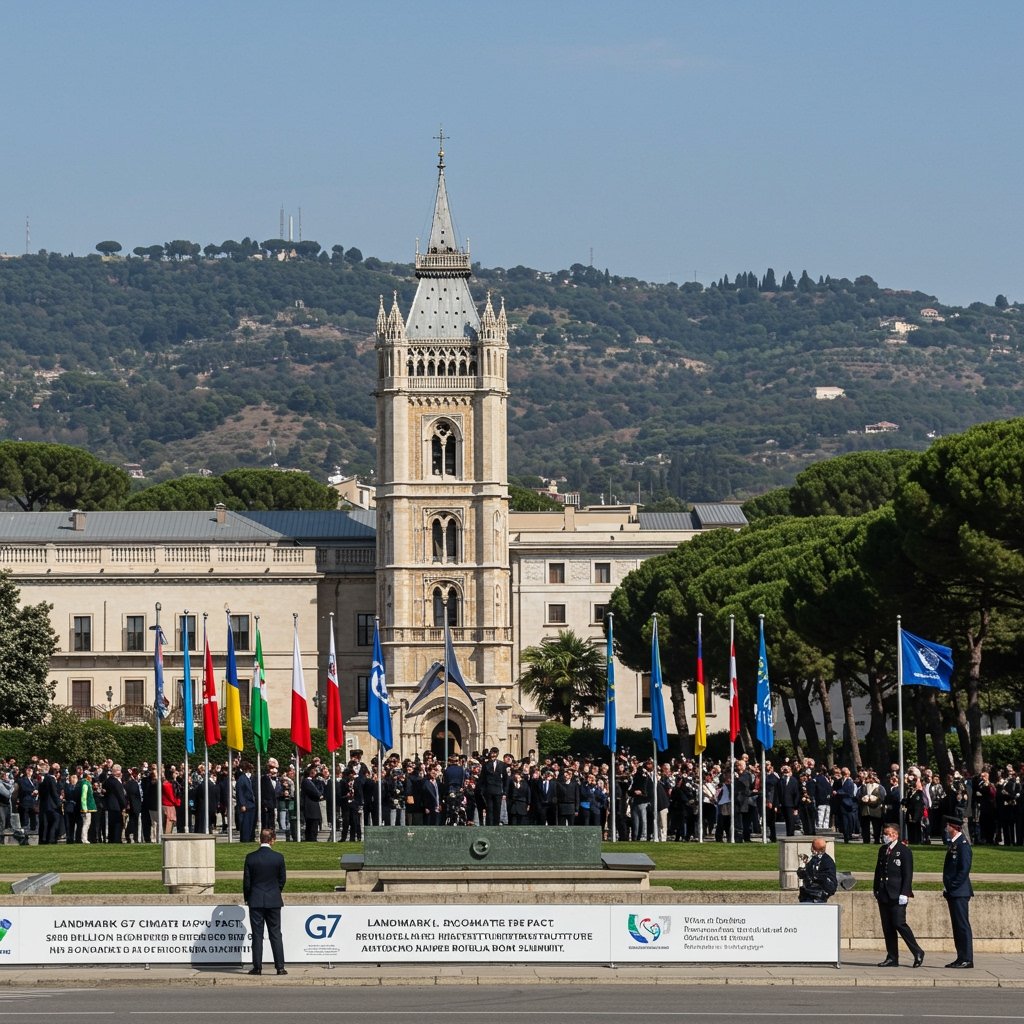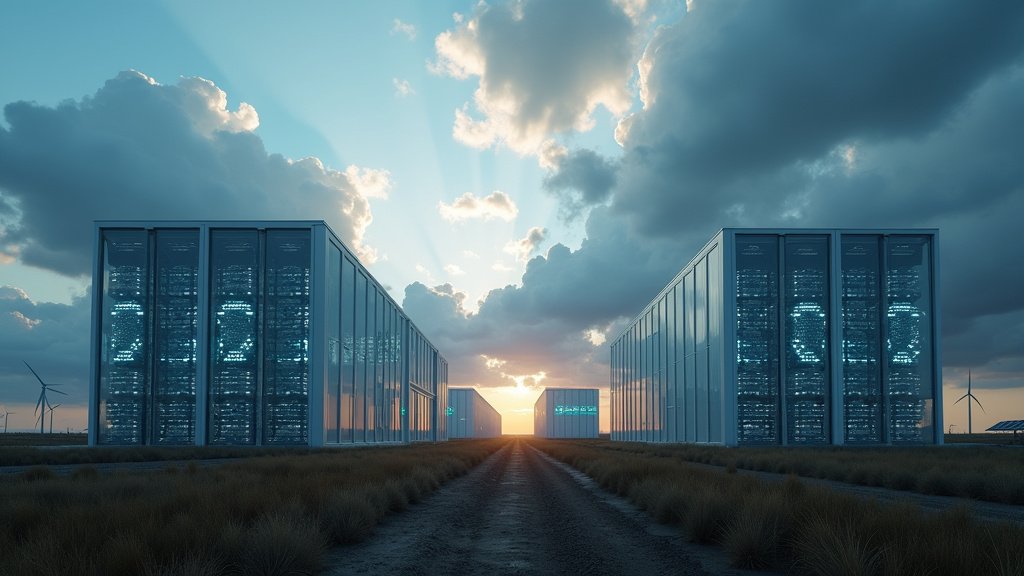Rome, Italy – Following intense multilateral negotiations, leaders from the Group of Seven (G7) nations concluded their annual summit here on May 31, 2025, with a significant joint declaration centered on global climate action and sustainable development. The capstone announcement of the summit was the unveiling of a joint “Green Future Investment Pact,” an ambitious agreement designed to significantly accelerate the transition to clean energy and build climate-resilient infrastructure in vulnerable economies.
This landmark pact commits the G7 member states to a collective mobilization of a minimum of $500 billion in both public and private funds over the next five years. This substantial financial commitment underscores the G7’s recognition of the urgent need for scaled-up investment to meet global climate targets, particularly in regions facing significant development challenges alongside increasing climate impacts.
The “Green Future Investment Pact”: Scale and Scope
The “Green Future Investment Pact” represents one of the most substantial climate finance commitments made by the G7 to date. The target figure of at least $500 billion over the five-year period spanning roughly 2025 through 2030 is intended to serve as a catalyst for both public sector investment and, critically, the unlocking of significantly larger flows of private capital. Leaders emphasized that the scale of the climate challenge necessitates innovative financial mechanisms that de-risk investments and make green projects in emerging markets attractive to institutional investors.
This half-trillion-dollar pledge is not merely aid; it is framed as strategic investment aimed at fostering sustainable economic growth while simultaneously tackling climate change. The pact envisages leveraging development finance institutions, green bonds, blended finance structures, and guarantees to mobilize the targeted funds. The precise breakdown between public and private contributions will depend on the specific projects and financing structures utilized, but the emphasis is clearly on using public funds strategically to crowd in private capital, which holds the vast majority of global financial resources.
Targeting Low- and Middle-Income Countries
A central focus of the “Green Future Investment Pact” is the earmarking of funds specifically for boosting renewable energy projects and developing sustainable infrastructure in low- and middle-income countries. These nations are often on the front lines of climate change impacts, facing challenges ranging from extreme weather events to rising sea levels and desertification. Simultaneously, many are experiencing rapid population growth and increasing energy demand, presenting both a challenge and an opportunity to leapfrog traditional fossil fuel-based development pathways.
The G7 leaders highlighted that supporting these countries is essential not only for global emissions reduction but also for fostering equitable development, enhancing energy security, and building resilience to climate shocks. Investments in renewable energy, such as large-scale solar farms, wind power projects, and grid modernization, are expected to provide reliable and affordable electricity, enabling industrial growth and improving living standards without increasing carbon footprints. Sustainable infrastructure projects could include things like climate-resilient transport networks, green urban development, sustainable water management systems, and circular economy initiatives.
Key Provisions: Subsidies and Technology Transfer
Beyond the financial commitment, the “Green Future Investment Pact” includes several critical policy provisions. A significant element is a reinforced timeline for phasing out inefficient fossil fuel subsidies by 2028. While G7 nations have previously committed to eliminating these subsidies, which distort energy markets and incentivize the use of polluting fuels, the 2028 deadline provides a concrete and accelerated target. This provision signals a strong intent by advanced economies to lead by example and remove financial support for technologies and practices that are incompatible with climate goals. Phasing out these subsidies is seen as crucial for leveling the playing field for renewable energy technologies and sending clear market signals in favor of clean alternatives.
The pact also establishes a new mechanism for green technology transfer. Recognizing that developing and deploying clean technologies globally is essential for rapid emissions reductions, this mechanism aims to facilitate the flow of knowledge, expertise, and technologies from G7 nations to low- and middle-income countries. This could involve supporting collaborative research and development, establishing technology demonstration projects, providing technical assistance and training, and exploring innovative approaches to intellectual property management to ensure widespread accessibility of critical green technologies like advanced battery storage, carbon capture, and smart grid systems. Accelerating the adoption of these technologies is vital for enabling recipient nations to transition to low-carbon economies more quickly and efficiently.
Aligning with Paris Agreement Targets
The overarching goal of the “Green Future Investment Pact” is to accelerate global emissions reductions aligned with Paris Agreement targets. The pact explicitly links its financial and policy commitments to the international goal of limiting global warming to well below 2 degrees Celsius above pre-industrial levels, and pursuing efforts to limit the increase to 1.5 degrees Celsius. By directing significant investment towards clean energy and sustainable infrastructure in countries poised for substantial growth, the G7 aims to help bend the global emissions curve downwards and support nations in achieving their Nationally Determined Contributions (NDCs) under the Paris Agreement.
The Rome summit served as a critical platform for reaffirming multilateral commitment to climate action amidst a complex global landscape. While challenges remain in mobilizing finance at the necessary scale and ensuring equitable distribution and effective implementation, the “Green Future Investment Pact” represents a concrete step forward by major global economies. Its success will ultimately depend on the dedicated follow-through by member states, the ability to effectively unlock private sector finance, and robust partnership with recipient countries to ensure projects are aligned with national development priorities and deliver tangible, sustainable benefits.
Leaders acknowledged that this pact is part of a broader effort that requires participation from all nations, as well as international financial institutions and the private sector. The commitments made on May 31, 2025, in Rome are intended to build momentum and provide a clear financial signal ahead of future international climate negotiations, reinforcing the G7’s stated commitment to a global green transition that is both rapid and inclusive.






